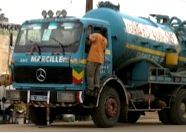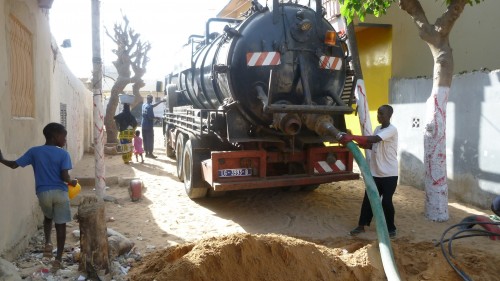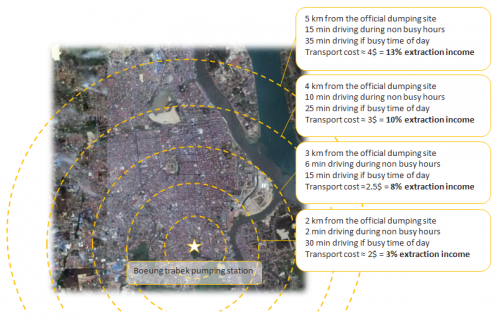The following post by guest blogger Pascal Garde on behalf of Doulaye Koné of the Bill and Melinda Gates Foundation (BMGF) refers to a recently published study on Fecal Sludge Management in Africa and Asia.
Non-sewered, or “on-site sanitation” is the main technological approach used in most urban areas in Africa and Asia. Use of this technology requires regular provision of human waste collection and transportation services, which are generally unregulated and usually provided by private operators.
There are currently huge information gaps on how collection and transportation of human waste is organized. Decision makers, entrepreneurs and investors often lack important information (e.g. market size, business opportunity, profitability) to make Fecal Sludge Management (FSM) a functional component of the sanitation value chain. However, providing safe emptying, transport, and treatment of human waste is critical to ensure healthy urban environments. In order to better understand the types of FSM services offered in two different regions, the Bill & Melinda Gates Foundation funded a study , entitled “Landscape and Business Analysis for FSM Emptying and Transportation in Africa and Asia” that analyzes these business segments in 30 cities across Africa and Asia.
The 30 cities were selected according to their size, geographic location, and the type of business models used in each. The findings of the study provide valuable insight into the urban FSM services (or lack of services) provided to over 67 million people (or over 12 million households). The comparison between the different cities was based on factors related to supply (e.g. business size, number of trucks, truck capacity), and demand for services (e.g. size of the city, household income, household occupation, etc.).
 Fecal sludge emptying and transportation service provider
Fecal sludge emptying and transportation service provider
The information used in the study was obtained by conducting detailed surveys in 13,000 households and with 150 fecal sludge emptying and transportation service providers. The findings of the study are intended to guide donors, investors and policymakers to enhance sustainable sanitation service provision in Africa and Asia.
The study highlights common practices and interesting differences between Africa and Asia. For example, the waste transport trucks used in Africa are second-hand (sometimes more than 30 years old) and imported from Europe, whereas in Asia trucks are 5 to 10 years old on average. The cost of a truck in Africa is almost three times higher than in Asia. Thus, reducing capital investment costs is critical to ensure the profitability of FSM service business in Africa.
 Waste transport truck in Senegal
Waste transport truck in Senegal
The operating costs of collection and transportation business services are also three times higher in Africa than in Asia — 76% of total costs are for fuel and maintenance. This may be due to a difference in truck size — truck capacities in Asia are just over 3m³, whereas in Africa trucks have about 10m³ capacity and therefore require more fuel. Despite the higher investment costs per truck in Africa, the average annual profit per truck is US$ 12,000, twice the profit in Asia.
In contrast, in Asia, fixed costs like salaries represent the majority (62%) of costs. With regard to fees for services, the average fee charged in Africa is US$ 60, compared to US$ 28 in Asia. The annual per truck profit is also higher in Africa because operators undertake twice as many trips to dumping sites or treatment plants than Asian ones. The best performing companies showed annual revenue ranging from $40,000 up to $2,000,000 per truck per annum, and a return on investment higher than 30 % for companies operating more than 2 trucks. The overall market size for fecal sludge emptying in the majority of the capital cities studied varied from $2.5 up to $43 million.
A large number of households surveyed (34 %) still use manual emptying by family members or paid laborers. This is a common practice in poor communities in Africa and Asia and is most often used when mechanical emptying fees are too expensive for households. Pits are generally emptied several times a year, or when the sludge in the pit is too thick or dry to pump. Manual pit emptying occurs also when access to pits is too difficult for mechanical emptiers due to truck size or bad road conditions The sludge emptied manually is often dumped or buried in the vicinity of the households while mechanically emptied sludge is discharged in most cities in open fields, in bodies of water, or used untreated for fertilizer or aquaculture. Hence, the uncompleted value chain in the current FSM scheme contributes to a high toll of preventable disease in poor communities.
 Mechanical emptying of sludge
Mechanical emptying of sludge
Based on this analysis, the study made a number of recommendations for how to improve the business environment for FSM, including creating transfer stations across the city to lower distance and therefore lower fuel costs, which make up to 40% of the variable costs of service providers in Africa. This would also increase the number of trips per day to collect sludge from households and generate more revenue. By reducing distances, transport costs decrease and more income is generated. As an example, the map below illustrates the impact that locating disposal sites based on the viability of the service in Phnom Penh could have.
The report also recommends:
- Encouraging formal registration, licensing and regulation of businesses by local authorities;
- Finding ways to scale up single trucks operators;
- Improving access to finance to purchase trucks;
- Encouraging scheduled desludging;
- Improving the local sourcing of trucks and the supply chain for parts and repairs;
- Increasing the number of sludge treatment plants
- Reducing access fees to sludge treatment plants; and
- Establishing re-use facilities.
 Fuel costs increase with distance of dumping site in Phnom Penh.
Fuel costs increase with distance of dumping site in Phnom Penh.
The study demonstrates that, with the support of local authorities, the market for sludge collection and transportation has great potential for investment and development of a healthy business environment, which would also indirectly contribute to better urban health and welfare in Africa and Asia.
In response to these challenges, the Bill & Melinda Gates Foundation is currently developing a set of technologies to make fecal sludge emptying easier and safer for operators, and increase their profitability. A technology called the omni-ingestor, is being developed to service the existing infrastructure (2.1 billion pits, cesspools, and septic tanks that require immediate servicing and/or maintenance). The Omni-ingestor will be safer, more affordable and amenable to users, and more sustainable for utilities, private companies, and municipalities by achieving the following goals:
- Lowering mechanical emptying prices for customers across the world to less than $5/ emptying cycle – 4 m³
- Improving access capabilities for mechanical emptying technologies
- Improving operator economics to ensure service continues and grows
- Reduce capital and operating cost to less or equal to current vaccuum trucks service
- Designing hand-operated, portable systems to provide current manual emptiers with adequate tools and the opportunity to become formal service providers
The foundation is also developing cost-effective and sustainable solutions for the processing or combined processing of fecal sludge and urban organic waste (omni-Processor). The omni-processor would support 1,000-5,000 people (or less) in an urban setting and have a capacity of 0.5-5 tons of waste per day. Ideally, processed waste will be converted into products that can be re-used such as electricity, biochar, gas, water or fertilizer and therefore generate revenue. This will offset waste collection costs, encourage technology acceptance and use, and increase the countries’ standard of living.
These types of innovations will begin to solve some of the complicated challenges that the fecal sludge management study highlights and, hopefully over time, reinvent the sanitation industry to make it more profitable for service providers and more accessible to everyone.

New blog post: Fecal Sludge Management in Africa and Asia http://t.co/1KUsbLTU
RT @saniblog: New blog post: Fecal Sludge Management in Africa and Asia http://t.co/1KUsbLTU
RT @JohnforWASH: The latest on Fecal Sludge Management in Africa and Asia – http://t.co/zXMER2OG @saniblog Thanks Pascal Garde.
RT @JohnforWASH: The latest on Fecal Sludge Management in Africa and Asia – http://t.co/zXMER2OG @saniblog Thanks Pascal Garde.
RT @JohnforWASH: The latest on Fecal Sludge Management in Africa and Asia – http://t.co/zXMER2OG @saniblog Thanks Pascal Garde.
I have serious concerns about one of the expressed goals of this initiative, specifically “Increasing the number of sludge treatment plants” and all that that encompasses. In the classic sense of the term “sludge treatment plants” refer to the incredibly energy and capital intensive systems that wealthy societies use to facilitate the release of toxic industrial waste into the environment while holding their citizens’ well-being hostage through a reliance and dependence on a system that costs an absurd amount of money to support and damages our environment. Sure centralized treatment plants have worked decently to reduce nutrient loading of our surface waters (and thus made possible the appearance of clean water) but they are a disaster in terms of the toxic sludge they produce (which most times ends up being dumped on open land and farm land) and the toxic substances which they do not remove or deposit in the sludge that are then discharged into our waterways. When are we going to come to terms with the fact that this system is broken?
Meanwhile, back in Africa, is it the right thing to be advocating for another centralized system itself so reliant on unsustainable transportation and expensive and energy intensive technology? We ourselves might be behind the “excreta solution curve” in the West but should that prevent us from recommending to African communities – who, it can be said, actually benefit from not already having an expensive system already in place – a new, much safer and less energy & capital intensive path?
In my opinion there are only two proven technologies out there that make any sense; urine diverting dehydration toilets (UDDT’s) and biodigesters. Homeowners, groups of homeowners, landlords, etc. can themselves directly benefit financially from the use of either technology to the exclusion of government and private industry. And this is likely why both simple concepts are so overlooked. Centralized systems, be they sewer or sludge treatment plants, are widely accepted financial engines which serve to make only a few people a lot of money. UDDT’s and biodigesters , on the other hand, insulate individuals, families and associations from the fluctuations in the market by allowing them produce several valuable byproducts; in the case of the former, raw urine, which is a wonderful (and safe) fertilizer, and dessicated and composted feces which is also a wonderful (and safe) fertilizer, and in the case of the latter, methane and composted excreta (AKA “soil”). These are products which they can make use of themselves or sell to others and/or area farmers for a profit. Government and private industry makes very little money under these scenarios. Neither technology produce a disgusting and difficult product that endangers workers health and requires an expensive fleet of pumper trucks to deal with. They don’t produce a product which ends up needing to be dumped on the edge of town or needs expensive and energy intensive treatment plants and oversight to keep from polluting the environment. They don’t produce a product that in its raw form routinely contaminates nearby surface and ground water sources. And after the initial construction cost outlay, neither requires people to regularly pay some outfit to haul something away. In fact, each allow folks to benefit themselves from the creation of valuable products. Farmers benefit from either because of being able to take advantage of low cost, locally produced and sustainable fertilizer instead of having to pay some huge multinational corporation for fertilizer produced via the use of fossil fuels and trucked in from far away. These simple and proven technologies allow local wealth to remain local, promote soil fertility and can even defend against deforestation (methane for cooking fuel instead of wood).
The Gates Foundation recently awarded prizes to winners of its “Reinventing the Toilet” boondoggle. Really? Why the need, I wonder, to reinvent what’s already in existence?
The technologies we have – UDDT’s and biodigesters – are infinitely scale-able, inexpensive, make use of local materials, are field maintainable by the people who rely on them, and produce valuable by-product that won’t hurt anyone and actually benefit the environment. The system discussed in the post above does just the opposite. Yet we continue to focus much of our energy on the latter to the detriment of the former. But, most importantly, to the detriment of the people we are supposedly trying to help. K.I.S.S. – Keep It Simple Stupid is the mindset we should be operating from, particularly now that we are beginning to navigate our low-energy future (the result of having already passed peak-oil). In the wake, communities around the world – in the East AND the West – need sustainable methods and systems now to deal with their excreta NOT antiquated, ineffective and expensive methods we came to take for granted during our brief love affair with cheap energy. The best thing we could do is to assist those poorest among us to create sustainable systems that will stand the test of time. Trucks, treatment plants, chemicals, etc., are not it.
Fecal Sludge Management in Africa and Asia http://t.co/dRs7oYZ8ea
I really love this. This should be implemented in all African countries. I am actually looking forward to initiating a similar plant in Kenya.